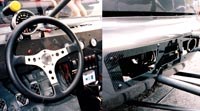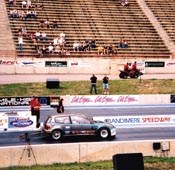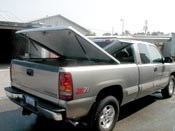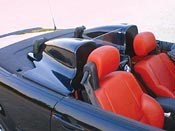Composite manufacturers thrive on products manufactured for the Automotive Aftermarket
Carbon and fiberglass accessories make up a big chunk of this multi-billion-dollar industry.
Composites play a key part in the growing automotive aftermarket - an industry dedicated to producing cosmetic accessories and performance-enhancing parts and equipment for cars, trucks and recreational vehicles. Hundreds of small to medium-sized composite fabricators turn out hoods, spoilers, air dams, bumpers, fenders, side skirts, step-assists, grilles, dashboards, interior trim, tonneau covers and more for a wide customer base.
Market retail value is estimated by the Specialty Equipment Market Assn. (SEMA) at nearly $30 billion (USD). The Automotive Aftermarket Industry Assn. (AAIA) tags the market size even higher at $237 billion with a 4 percent annual growth rate, if car care products, repair, tires and other ancillary categories are included.
The growth of the Internet over the last five years has broadened formerly regional sales, and buyers are surprisingly young - and willing to spend. According to SEMA statistics, 62 percent of those modifying their car are between the ages of 18 and 25, and a huge number drive imported front-wheel drive compact cars. These buyers can be generally categorized as 1) those wanting a purely cosmetic upgrade; 2) those wanting a performance enhancement for higher speed (as well as good looks); or 3) pure racers who need lighter weight for better results at the drag strip.
"Racing and race cars have fostered a lot of the development in the aftermarket," states Hank Johns, president of Graphite Master (Los Angeles, Calif., U.S.A.), a distributor of composite materials to many aftermarket manufacturers. "People are keeping their cars longer today and are willing to spend the money to customize and create a unique look that's different than an assembly-line vehicle."
"It's a big market with a lot of revenue potential," says Dean Massab, vice president of sales and marketing for Roush Performance Products (Livonia, Mich., U.S.A.). "But it's a very fragmented market, essentially a cottage industry." This article offers a brief examination of some of the companies, parts and manufacturing techniques involved in this quixotic market.
The composite material range in aftermarket parts is enormous, from filled thermoplastics to carbon/epoxy prepregs. Many manufacturers face the challenge of producing low-run, high-quality parts that are safe and affordable, while recouping design, tooling and material costs. Buyers' tastes vary widely and styles can change rapidly, which dictates fast design cycles. And, major automotive OEMs themselves have begun to produce more "niche" vehicles appealing to smaller market segments, which, in turn, multiplies the options for aftermarket customization. In response, composite fabricators have adopted unique and practical methods for making their parts profitably.
"You've got to be fluid in your ability to adjust to the market," says Thomas Jones, production manager of Prestigious Accessories Inc. (Winona, Texas, U.S.A.). "You constantly have to evolve as OEM designs change." Case in point is the Sport Utility Vehicle (SUV) category.
A step in the right direction
Most large SUV owners will admit that it's an awkward step up to the driver's or passenger's seat, and any assistance is welcome. Prestigious Accessories has taken advantage of that fact for the past 20 years. Jones, Prestigious' production manager, says the firm started producing step assists for the Chevrolet Suburban in the mid-1980s, along with custom van conversion kits. While the van market has slowed, Prestigious has continued to produce composite bolt-on steps for SUVs like the Ford Expedition and Chevrolet vans, along with air dams, spoilers, hood scoops, and rear roll pans (truck rear bumper replacement parts that match the profile of the tail gate and fenders for a smooth, aerodynamic look).
"The Suburban's styling didn't change for about 10 years after the model was introduced," says Jones. "Today, OEM styling changes are frequent and can be very expensive for aftermarket parts makers if you don't keep tooling and material costs down."
To keep costs low while keeping up with model changes, the company makes its bolt-on steps in simple, open fiberglass molds that it produces in-house in a matter of days from machined high-density foam plugs. Tools are laminated with a filled tooling resin system from Reichhold Inc. (Research Triangle Park, N. C., U.S.A.) and glass tooling cloth. The filler in the resin reduces exotherm, which allows fast buildup of a thicker tool laminate, says Jones. Backup structures for the molds are constructed from dimensional lumber and fitted with castors for easy mobility.
Prestigious has the capability to make steps up to 19 ft long, as wide as 10 inches and as much as four inches high. After a wipe-on mold release is applied, a gray "sanding" gel coat from Valspar Composites (Elkhart, Ind., U.S.A.) sprayed into the mold. "The sanding gel coat means the finish is easy to sand and prepare for paint," explains Jones. Using chopper gun equipment from Binks (part of ITW Industrial Finishing, Glendale Heights, Ill., U.S.A.), technicians then spray up a combination of polyester resin, from Resolution Specialty Materials (Carpentersville, Ill., U.S.A., formerly Eastman Chemicals Co., Composite Polymers Group), and low-cost chopped fiberglass roving. To obtain the desired stiffness and to provide adequate fastener "bite," the company uses 0.75-inch/18-mm-thick, high-density particleboard as a core material along the length of the part. All parts are cured at room temperature. "Wood is definitely not 'aerospace,' but it really works better than anything else for ensuring the mounting brackets and screws hold the part to the vehicle securely," says Jones.
Prestigious' parts are sold unpainted to customers so they can be adapted to any color scheme, and the majority of the running boards produced are sold through distributors to auto dealers who offer them as a vehicle option. Jones cites growth of the Internet as a significant factor in bringing in a broader base of customers.
"We are constantly developing new ideas as well as new materials," he says. "The market's more difficult to predict these days, so we try to be prepared."
Covers for trucks and sports cars
The pickup aftermarket, likewise, is a huge business, and bed covers represent a big slice of the pie. Pickup trucks number in the millions in the U.S. - over 3 million were sold in the U.S. in 2002, according to the U.S. Department of Energy. Tri-Glas Corp. (Daleville, Ala., U.S.A.), together with sister-company Glasstite (Dunnell, Minn., U.S.A.) is one of many manufacturers of fiberglass bed covers. Corporate parent Penda Corp. (Portage, Wis., U.S.A.) is the largest U.S. manufacturer of pickup bedliners.
Tri-Glas produces several types of pickup bed, or tonneau, covers for a wide range of OEM vehicles, says general manager Sherrill Whitaker. The company's innovative TriWing cover is designed with three hinged hatches, one on each side and the third operated from the tailgate. Parts are made in three open fiberglass molds that are produced in-house. After a liquid wipe-on mold release is applied, a sanding primer gel coat from Interplastic Corp., Thermoset Resins Div. (St. Paul, Minn., U.S.A.) is sprayed into the mold. Next, a "skin layer" is sprayed up, using AOC Resins (Collierville, Tenn., U.S.A.) polyester resin and glass gun roving. Once the skin coat has cured, an unfaced kraft paper honeycomb core from Tricel Honeycomb Corp. (Gurnee, Ill., U.S.A.) is applied over the entire part. "The Tricel honeycomb provides the stiffness we need for the parts, at a much lower cost than structural honeycomb materials," states Whitaker.
A final layer of chopped glass is sprayed directly over the honeycomb and parts are cured at room temperature. Barcol hardness is monitored to ensure complete cure and prevent any honeycomb print-though. Once demolded, the fiberglass covers are trimmed, sanded and painted to OEM specs. Then, a powdercoated steel frame with specially designed hinges is attached to the covers with steel screws. The TriWing is sold not only to aftermarket customers but also to truck dealerships, where it is offered as a dealer option.
VS Composites LLC (Garden Ridge, Texas, U.S.A.) has perfected a cost-effective and innovative tooling concept that - teamed with vacuum-assisted resin transfer molding (VARTM) - allows profitable, low-volume production of a complex-shaped tonneau cover for BMW M3 series convertibles, says owner Mike Van Steenburg. The M3 cover features a three-layer extruded thermoplastic film, which replaces both gel coat and paint. The 0.76 mm/0.030-inch thick material typically consists of an inner layer of ABS, a pigmented middle layer and an outer acrylic layer for high gloss. The sheet is heated slightly, then vacuum-formed over a low-cost ceramic/epoxy vacuum fixture in the shape of the part. Tooling material comes from ADTECH Plastic Systems, div. of Cass Polymers, Charlotte, Mich., U.S.A.). Vacuum pressure pulls the warm film tightly against the fixture. Once cool, the film is demolded and placed in a holding fixture formed over a simple wood-and-steel backup structure, using inexpensive fairing compound material, such as Bondo from Laminex, div. of Bondo Corp., Atlanta, Ga., U.S.A.).
"The thermoformed skin holds the shape of the part, and acts as a layup tool, yet still provides a Class A finish," says Van Steenburg. Thermoplastic films as a paint replacement are being adopted by OEMs like DaimlerChrysler, which uses the material for the SMART Roadster roof - the roof recently won the Grand Award at the 33rd annual Society of Plastics Engineers (SPE) Innovation Awards event in Detroit last November and will be the subject of an upcoming "Inside Manufacturing" (CT October 2004).
To make the M3 tonneau, VS Composites places three plies of 0/90 woven carbon fiber cloth from Hexcel into the formed skin. The layup is vacuum-bagged and edge-sealed in preparation for resin infusion. A tiny hole drilled in an unobtrusive location in the skin acts as the resin inlet, and vacuum is pulled around the perimeter. VS opts to use higher-performing CoRezyn vinyl ester from Interplastic or epoxy from SP Systems (Newport, Isle of Wight, U.K.), instead of polyester, for the infusion resins. Infusion is usually complete within five minutes, and the parts are oven cured at 49°C/120°F for about two hours, says Van Steenburg.
In addition to the tonneau, VS Composites also produces custom aftermarket body kits (body panels that completely change the look of a car) for a number of vehicle models and manufactures parts for OEM programs as well (e.g., the carbon/vinyl ester battery tray for DaimlerChrysler's EPIC electric minivan). Under development is a radical new production method in which carbon fiber is powdercoated with thermoplastic resin, then subjected to an electrical current (to melt the resin) while being pressed in a high-speed compression mold. The company claims 15-second cycle times are possible for structural carbon fiber components. "Our methods are cost-effective in low volumes while delivering quality," concludes Van Steenburg.
Carbon fiber "look" a hot trend
The allure of carbon fiber accents for interior and exterior parts (and under the hood) is responsible for growing sales in the "tuner" segment - that is, drivers of modified, primarily front-wheel drive, sport compact cars from Honda, Mazda and Nissan. Buyers want carbon because of its "look," but nearly everyone interviewed for this article reports that part quality and appearance is often less than perfect. (In some cases, screen-printed plastics are being passed off as "carbon" material.) This provides ample opportunities for competent composite manufactures to offer high-quality material forms.
"I've been to the tuner car shows and seen the poor surface finish on many carbon fiber parts," says Adam Weeks of MacLean Quality Composites (MQC, West Jordan, Utah, U.S.A.). "Many of these parts have poor fit tolerances, obvious weave distortion and loose fiber ends because of bucket-and-brush hand layup and out-of-autoclave processing."
Weeks set out to improve quality with a new carbon fiber/epoxy flat sheet product called RacePlates that customers cut to shape and install for a true carbon fiber "look." The flat prepreg sheet stock comes in varying sizes, in two different thicknesses. The "Rigid" version is an eight-ply sheet, with six plies of unidirectional carbon/epoxy prepreg tape from Toray Carbon Fibers America Inc. (Flower Mound, Texas, U.S.A.) in the center and one ply of woven 3K carbon prepreg 2/2 twill on each side, typically supplied by Advanced Composites Group Inc. (ACG, Tulsa, Okla., U.S.A.). The prepreg is layed up on polished steel caul plates and autoclave cured for a high-gloss Class A finish on both sides. Customers can cut the rigid plate with readily available hand-held tools, like a Dremel cutter. A thinner 0.25 mm/0.010-inch thick "Flex" version is made from a single ply of prepreg/epoxy twill that can be easily cut with scissors and attached to any surface with double-sided tape. Customers use the stock to create unique one-of-a-kind parts like custom dashboards, gauge panels, interior trim such as door panels, underhood trim and exterior wings. Parts like speaker enclosures can be created when the flat sheet is combined with RacePlates carbon angle stock for the corners.
MacLean, also the manufacturer of the carbon fiber hood for GM's 2004 Corvette Z06 Commemorative Edition, sponsors several tuner car racers who have incorporated RacePlates for enhanced performance. One is Joe Housley of Sandy, Utah, U.S.A., who drives a 1992 Honda Civic in the National Hot Rod Assn.'s (NHRA) Sport Compact drag racing series. CT got a chance to see Housley and his Pro Class car in action at the series' inaugural event at Bandimere Speedway, west of Denver, Colo., U.S.A. Housley has incorporated RacePlates in a custom dash, a floor panel on which the car's electronics are mounted, door panels and a rear diffuser an insert in the rear bumper with rectangular openings that lets air through the bumper, decreasing overall drag on the car. MacLean recently introduced a sunroof plug kit that replaces a car's glass sunroof with a waterjet-cut RacePlates panel. The plug kit for a 1995 Honda Civic weighs just over 2 lb, compared to the factory's original 35-lb installation, and costs about $350 (USD). "The sunroof plug takes a huge amount of weight out of the highest part of the car," says Weeks. "This translates to a lower center of gravity and better racing performance."
Myriad other manufactured, bolt-on carbon fiber products are available as well. Components range from carbon fiber hoods like those manufactured by Advanced Composite Specialties-US Inc. (Troy, Mich., U.S.A.) to the carbon fiber air intake box on the supercharger kit for Honda's S2000, from Comptech Sport's (El Dorado Hills, Calif., U.S.A.).
Carbon Concept Inc. (Ballston Spa, N.Y., U.S.A.) makes carbon aftermarket parts for Subaru vehicles, including a new resin transfer molded gearshift knob. High-density closed-cell foam is machined into shape, then covered with a carbon braid from A&P Technology Inc. (Cincinnati, Ohio, U.S.A.). The layup is placed in an in-house-fabricated closed cast epoxy mold, and D.E.R. brand epoxy resin from The Dow Chemical Co. (Midland, Mich., U.S.A.) is injected at a pressure of about 60 psi. Once demolded, the knob's top center is covered with a decal followed by a clearcoat finish. A machined plastic threaded fastener that attaches the knob to the gear shift selector lever is adhesively bonded to the knob.
While weight reduction for performance is important to racers, Graphite Master's Johns points out that success in the aftermarket is mainly due to cosmetic appearance and surface finish. He distributes, as part of a range of Hexcel (Dublin, Calif., U.S.A.) fabrics and prepregs, a relatively new material called Texalium, an aluminized glass 2/2 twill that is available as a fabric, as an epoxy prepreg or as a cured laminate sheet. Hexcel deposits aluminum powder on one side of the glass fabric via a proprietary process, creating the look of woven metal. Johns says he sells ever-growing quantities to fabricators of steering wheel inserts, dashboard panels and interior trim kits, and thinks that a "metallic" look may be the next trend.
"There's no reason to believe that the carbon look or this new 'metal look' will go out of style," says Johns. "Stainless steel, brushed aluminum and wood are all well-known materials for auto interiors. In my opinion, carbon and materials like Texalium will join them as standard choices."
"It's all about customization," Johns sums up. "Composite fabricators can take advantage of the consumer's thirst for one-of-a-kind, unique vehicles." Based on the size and growth of the automotive aftermarket, customers have demonstrated their readiness to buy despite somewhat uncertain economic times. As the economy takes a turn for the better, the market it drives can only pick up speed.
Related Content
Materials & Processes: Composites fibers and resins
Compared to legacy materials like steel, aluminum, iron and titanium, composites are still coming of age, and only just now are being better understood by design and manufacturing engineers. However, composites’ physical properties — combined with unbeatable light weight — make them undeniably attractive.
Read MoreMaterials & Processes: Tooling for composites
Composite parts are formed in molds, also known as tools. Tools can be made from virtually any material. The material type, shape and complexity depend upon the part and length of production run. Here's a short summary of the issues involved in electing and making tools.
Read MoreSaint-Gobain, Roctool join efforts to boost composite 3D textile preform parts manufacturing
3D automated knitted preform layup technology and heat and cooling technologies for additional curing efficiency open a new window of application opportunities for composite and thermoplastic parts.
Read MorePlataine unveils AI-based autoclave scheduling optimization tool
The Autoclave Scheduler is designed to increase autoclave throughput, save operational costs and energy, and contribute to sustainable composite manufacturing.
Read MoreRead Next
From the CW Archives: The tale of the thermoplastic cryotank
In 2006, guest columnist Bob Hartunian related the story of his efforts two decades prior, while at McDonnell Douglas, to develop a thermoplastic composite crytank for hydrogen storage. He learned a lot of lessons.
Read MoreComposites end markets: Energy (2024)
Composites are used widely in oil/gas, wind and other renewable energy applications. Despite market challenges, growth potential and innovation for composites continue.
Read MoreCW’s 2024 Top Shops survey offers new approach to benchmarking
Respondents that complete the survey by April 30, 2024, have the chance to be recognized as an honoree.
Read More


























.jpg;maxWidth=300;quality=90)








